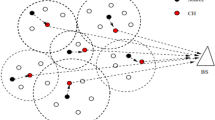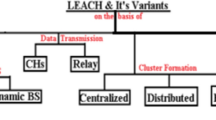Abstract
Internet of things consist in the deployment of constrained and battery-powered devices with a radio interface. Most industrial applications require to respect strict reliability and delay constraints. Lossy links imply mechanisms to retransmit the packets to improve the reliability. However, transient faults (e.g. obstacles, interference) may also impact the reliability, and require to change the routes. In this article, we present cooperative storing mode (CoopStor), that detects the faults and triggers action before a packet is dropped. In particular, the packets are cooperatively stored in the network, until the routing protocol re-converges. The congested zone gradually increases to serve as a local storage facility. CoopStor relies on a selection of relay and leaf nodes to reduce the energy consumption while providing a low end-to-end delay in steady state. Our performance evaluation campaign highlights a reduction of packet drops and an improved energy-efficient data collection procedure.








Similar content being viewed by others
References
802.15.4-2006-IEEE Standard for Local and metropolitan area networks–Specific requirements–Part 15.4: Wireless Medium Access Control (MAC) and Physical Layer (PHY) Specifications for Low Rate Wireless Personal Area Networks (WPANs). IEEE Std. 802.15.4-2006 (2006)
Ahmed, A. M., & Paulus, R. (2017). Congestion detection technique for multipath routing and load balancing in wsn. Wireless Networks, 23(3), 881–888. https://doi.org/10.1007/s11276-015-1151-5.
Ahn, G. S., Hong, S. G., Miluzzo, E., Campbell, A. T., & Cuomo, F. (2006). Funneling-mac: A localized, sink-oriented mac for boosting fidelity in sensor networks. In: SenSys, pp. 293–306. ACM, New York, NY, USA. https://doi.org/10.1145/1182807.1182837.
Ahrar, E. M., Nassiri, M., & Theoleyre, F. (2019). Multipath aware scheduling for high reliability and fault tolerance in low power industrial networks. Journal of Network and Computer Applications, 142, 25–36.
Arshad, S., Azam, M. A., Rehmani, M. H., & Loo, J. (2019). Recent advances in information-centric networking-based internet of things (icn-iot). IEEE Internet of Things Journal, 6(2), 2128–2158. https://doi.org/10.1109/JIOT.2018.2873343.
Chen, P., Sung, M., & Cheng, S. (2016). Buffer occupancy and delivery reliability tradeoffs for epidemic routing. CoRR abs/1601.06345. http://arxiv.org/abs/1601.06345
De Couto, D. S. J., Aguayo, D., Bicket, J., & Morris, R. (2005). A high-throughput path metric for multi-hop wireless routing. Wireless Networks, 11(4), 419–434. https://doi.org/10.1007/s11276-005-1766-z.
Dobslaw, F., Zhang, T., & Gidlund, M. (2016). End-to-end reliability-aware scheduling for wireless sensor networks. IEEE Transactions on Industrial Informatics, 12(2), 758–767. https://doi.org/10.1109/TII.2014.2382335.
Gnawali, O., & Levis, P. (2012). The minimum rank with hysteresis objective function. RFC 6719 (Proposed Standard) http://www.ietf.org/rfc/rfc6719.txt
Gorla, E., & Ravagnani, A. (2018). An algebraic framework for end-to-end physical-layer network coding. IEEE Transactions on Information Theory, 64(6), 4480–4495. https://doi.org/10.1109/TIT.2017.2778726.
IEEE Standard for Low-Rate Wireless Networks: IEEE Std 802.15.4-2015 (Revision of IEEE Std 802.15.4-2011) (2016)
IEEE Standard for Local and metropolitan area networks–Part 15.4: Low-Rate Wireless Personal Area Networks (LR-WPANs) Amendment 1: MAC sublayer. IEEE Std. 802.15.4e-2012 (2012)
Iova, O., Theoleyre, F., & Noel, T. (2015). Using multiparent routing in RPL to increase the stability and the lifetime of the network. Ad Hoc Networks, 29, 45–62. https://doi.org/10.1016/j.adhoc.2015.01.020.
Iova, O., Theoleyre, F., Watteyne, T., & Noel, T. (2017). The love-hate relationship between IEEE 802.15.4 and rpl. IEEE Communications Magazine, 55(1), 188–194.
Jan, M. A., Jan, S. R. U., Alam, M., Akhunzada, A., & Rahman, I. U. (2018). A comprehensive analysis of congestion control protocols in wireless sensor networks. Mobile Networks and Applications,. https://doi.org/10.1007/s11036-018-1018-y.
Jenschke, T.L., Papadopoulos, G.Z., Koutsiamanis, R.A., & Montavont, N. (2019). Alternative parent selection for multi-path RPL networks. In Proceedings of the 5th IEEE world forum on internet of things (WF-IoT) (pp. 533–538).
Ji, C., Koutsiamanis, R.A., Montavont, N., Chatzimisios, P., Dujovne, D., & Papadopoulos, G.Z. (2018). TAOF: Traffic aware objective function for RPL-based networks. In Proceedings of the global information infrastructure and networking symposium (GIIS) (pp. 1–5).
Kafi, M. A., Ben-Othman, J., Ouadjaout, A., Bagaa, M., & Badache, N. (2017). Refiacc: Reliable, efficient, fair and interference-aware congestion control protocol for wireless sensor networks. Computer Communications, 101, 1–11. https://doi.org/10.1016/j.comcom.2016.05.018.
Kim, H. S., Kim, H., Paek, J., & Bahk, S. (2017). Load balancing under heavy traffic in rpl routing protocol for low power and lossy networks. IEEE Transactions on Mobile Computing, 16(4), 964–979. https://doi.org/10.1109/TMC.2016.2585107.
Korte, K.D., Sehgal, A., & Schönwälder, J. (2012). A study of the rpl repair process using contikirpl. In International conference on autonomous infrastructure, management, and security (AIMS) (pp. 50–61). IFIP, Luxembourg, Luxembourg. https://doi.org/10.1007/978-3-642-30633-4_8
Koutsiamanis, R. A., Papadopoulos, G. Z., Jenschke, T. L., Thubert, P., & Montavont, N. (2020). Meet the PAREO functions: Towards reliable and available wireless networks. In Proceedings of the IEEE international conference on communications (ICC).
Lien, S. Y., Hung, S. C., Deng, D. J., & Wang, Y. J. (2017). Efficient ultra-reliable and low latency communications and massive machine-type communications in 5g new radio. In GLOBECOM (pp. 1–7). IEEE https://doi.org/10.1109/GLOCOM.2017.8254211.
Mahmood, M. A., Seah, W. K., & Welch, I. (2015). Reliability in wireless sensor networks: A survey and challenges ahead. Computer Networks, 79, 166–187. https://doi.org/10.1016/j.comnet.2014.12.016.
Merlin, C. J., & Heinzelman, W. B. (2010). Duty cycle control for low-power-listening mac protocols. IEEE Transactions on Mobile Computing, 9(11), 1508–1521. https://doi.org/10.1109/TMC.2010.116.
Muralidharan, S., Sahu, B. J. R., Saxena, N., & Roy, A. (2017). Ppt: A push pull traffic algorithm to improve qos provisioning in iot-ndn environment. IEEE Communications Letters, 21(6), 1417–1420. https://doi.org/10.1109/LCOMM.2017.2677922.
Papadopoulos, G. Z., Pappas, N., Gallais, A., Noel, T., & Angelakis, V. (2015). Distributed adaptive scheme for reliable data collection in fault tolerant WSNs. In World forum on internet of things (WF-IoT) (pp. 116–121). IEEE.
Pappas, N., Gunnarsson, J., Kratz, L., Kountouris, M., & Angelakis, V. (2015). Age of information of multiple sources with queue management. In 2015 IEEE international conference on communications (ICC)
Ruan, Z., Luo, H., & Chen, Z. (2016). Improving reliability of erasure codes-based storage paradigm under correlated failures for wireless sensor networks. International Journal of Communication Systems, 29, 992–1011.
Spyropoulos, T., Psounis, K., & Raghavendra, C. S. (2005). Spray and wait: An efficient routing scheme for intermittently connected mobile networks. In Workshop on delay-tolerant networking (WDTN) (pp. 252–259). ACM SIGCOMM, Philadelphia, Pennsylvania, USA. https://doi.org/10.1145/1080139.1080143.
Sun, Y., Song, H., Jara, A. J., & Bie, R. (2016). Internet of things and big data analytics for smart and connected communities. IEEE Access, 4, 766–773. https://doi.org/10.1109/ACCESS.2016.2529723.
Swamy, V.N., Rigge, P., Ranade, G., Sahai, A., & Nikolić, B. (2016). Network coding for high-reliability low-latency wireless control. In Wireless communications and networking conference (WCNC) (pp. 1–7). IEEE. https://doi.org/10.1109/WCNC.2016.7564660.
Teles Hermeto, R., Gallais, A., & Theoleyre, F. (2017). Scheduling for IEEE802.15.4-TSCH and slow channel hopping MAC in low power industrial wireless networks. Computer and Communications, 114(C), 84–105.
Theoleyre, F. (2011). A route-aware MAC for wireless multihop networks with a convergecast traffic pattern. Computer Networks, 55(3), 822–837. https://doi.org/10.1016/j.comnet.2010.10.018.
Theoleyre, F., & Papadopoulos, G.Z. (2016). Experimental validation of a distributed self-configured 6tisch with traffic isolation in low power lossy networks. In International conference on modeling, analysis and simulation of wireless and mobile systems (MSWiM) (pp. 102–110). ACM https://doi.org/10.1145/2988287.2989133.
Vilajosana, X. et al. (2015). Minimal 6tisch configuration. https://datatracker.ietf.org/doc/draft-ietf-6tisch-minimal/, IETF.
Wang, E., Yang, Y., & Wu, J. (2015). A knapsack-based message scheduling and drop strategy for delay-tolerant networks. In International conference on embedded wireless systems and networks (EWSN) (pp. 120–134). https://doi.org/10.1007/978-3-319-15582-1_8.
Winter, T., Thubert, P., Brandt, A., Hui, J., Kelsey, R., & Levis, P., et al. (2012). RPL: IPv6 routing protocol for low-power and lossy networks. IETF: technical representative.
Wu, C., Ji, Y., Xu, J., Ohzahata, S., & Kato, T. (2014). Coded packets over lossy links: A redundancy-based mechanism for reliable and fast data collection in sensor networks. Computer Networks, 70, 179–191. https://doi.org/10.1016/j.comnet.2014.05.010.
Zhang, L., Afanasyev, A., Burke, J., Jacobson, V., Claffy, k., Crowley, P., Papadopoulos, C., Wang, L., & Zhang, B., (2014). Named data networking. SIGCOMM Computer Communication Review, 44(3), 66–73. https://doi.org/10.1145/2656877.2656887.
Acknowledgements
This work was partly supported by the French National Research Agency (ANR) project Nano-Net under contract ANR-18-CE25-0003.
Author information
Authors and Affiliations
Corresponding author
Additional information
Publisher's Note
Springer Nature remains neutral with regard to jurisdictional claims in published maps and institutional affiliations.
Rights and permissions
About this article
Cite this article
Papadopoulos, G.Z., Mavromatis, A., Gallais, A. et al. CoopStor: a cooperative reliable and efficient data collection protocol in fault and delay tolerant wireless networks. Wireless Netw 27, 367–381 (2021). https://doi.org/10.1007/s11276-020-02461-6
Published:
Issue Date:
DOI: https://doi.org/10.1007/s11276-020-02461-6




